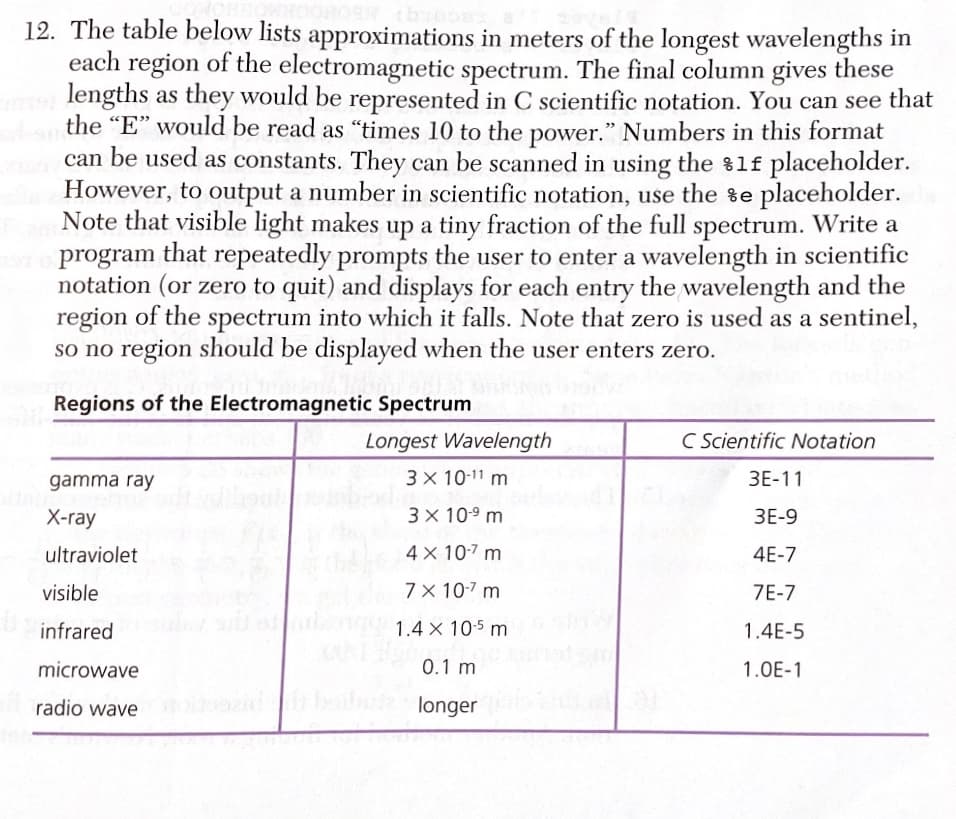12. The table below lists approximations in meters of the longest wavelengths in each region of the electromagnetic spectrum. The final column gives these m lengths as they would be represented in C scientific notation. You can see that the "E" would be read as "times 10 to the power." Numbers in this format can be used as constants. They can be scanned in using the %lf placeholder. However, to output a number in scientific notation, use the %e placeholder. Note that visible light makes up a tiny fraction of the full spectrum. Write a program that repeatedly prompts the user to enter a wavelength in scientific notation (or zero to quit) and displays for each entry the wavelength and the region of the spectrum into which it falls. Note that zero is used as a sentinel, so no region should be displayed when the user enters zero. Regions of the Electromagnetic Spectrum C Scientific Notation Longest Wavelength x 10-11 m 3 ЗЕ-11 gamma ray 3 x 109 m ЗЕ-9 X-ray 4 x 107 m ultraviolet 4E-7 7 X 10-7 m visible 7E-7 1.4 X 10-5 m infrared 1.4E-5 0.1 m microwave 1.0E-1 longer radio wave
12. The table below lists approximations in meters of the longest wavelengths in each region of the electromagnetic spectrum. The final column gives these m lengths as they would be represented in C scientific notation. You can see that the "E" would be read as "times 10 to the power." Numbers in this format can be used as constants. They can be scanned in using the %lf placeholder. However, to output a number in scientific notation, use the %e placeholder. Note that visible light makes up a tiny fraction of the full spectrum. Write a program that repeatedly prompts the user to enter a wavelength in scientific notation (or zero to quit) and displays for each entry the wavelength and the region of the spectrum into which it falls. Note that zero is used as a sentinel, so no region should be displayed when the user enters zero. Regions of the Electromagnetic Spectrum C Scientific Notation Longest Wavelength x 10-11 m 3 ЗЕ-11 gamma ray 3 x 109 m ЗЕ-9 X-ray 4 x 107 m ultraviolet 4E-7 7 X 10-7 m visible 7E-7 1.4 X 10-5 m infrared 1.4E-5 0.1 m microwave 1.0E-1 longer radio wave
C++ Programming: From Problem Analysis to Program Design
8th Edition
ISBN:9781337102087
Author:D. S. Malik
Publisher:D. S. Malik
Chapter15: Recursion
Section: Chapter Questions
Problem 20PE
Related questions
Question
Computer Language: C

Transcribed Image Text:12. The table below lists approximations in meters of the longest wavelengths in
each region of the electromagnetic spectrum. The final column gives these
m lengths as they would be represented in C scientific notation. You can see that
the "E" would be read as "times 10 to the power." Numbers in this format
can be used as constants. They can be scanned in using the %lf placeholder.
However, to output a number in scientific notation, use the %e placeholder.
Note that visible light makes up a tiny fraction of the full spectrum. Write a
program that repeatedly prompts the user to enter a wavelength in scientific
notation (or zero to quit) and displays for each entry the wavelength and the
region of the spectrum into which it falls. Note that zero is used as a sentinel,
so no region should be displayed when the user enters zero.
Regions of the Electromagnetic Spectrum
C Scientific Notation
Longest Wavelength
x 10-11 m
3
ЗЕ-11
gamma ray
3 x 109 m
ЗЕ-9
X-ray
4 x 107 m
ultraviolet
4E-7
7 X 10-7 m
visible
7E-7
1.4 X 10-5 m
infrared
1.4E-5
0.1 m
microwave
1.0E-1
longer
radio wave
Expert Solution
This question has been solved!
Explore an expertly crafted, step-by-step solution for a thorough understanding of key concepts.
This is a popular solution!
Trending now
This is a popular solution!
Step by step
Solved in 4 steps with 2 images

Knowledge Booster
Learn more about
Need a deep-dive on the concept behind this application? Look no further. Learn more about this topic, computer-science and related others by exploring similar questions and additional content below.Recommended textbooks for you

C++ Programming: From Problem Analysis to Program…
Computer Science
ISBN:
9781337102087
Author:
D. S. Malik
Publisher:
Cengage Learning

C++ Programming: From Problem Analysis to Program…
Computer Science
ISBN:
9781337102087
Author:
D. S. Malik
Publisher:
Cengage Learning